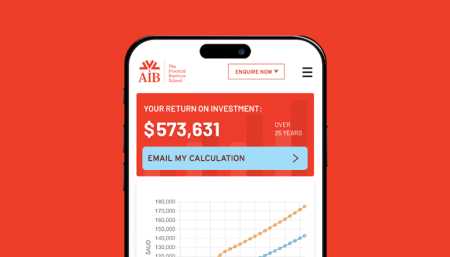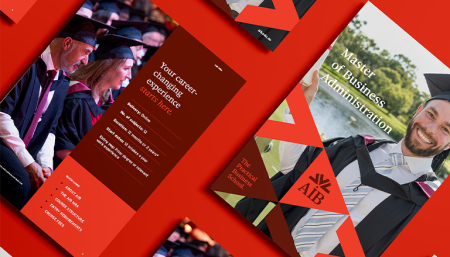Leading Beyond HR: A People and Culture Perspective

In leadership, it’s easy to be defined by your function, especially in People and Culture. But for Caroline Monzon, Executive General Manager of People and Culture at Essendon Football Club, things started to shift when she began seeing her role not as limited to HR, but as a bridge to broader organisational impact.
At our AIBconnect event in Melbourne, Caroline shared her approach to leadership in complex, people-driven environments. From building trust and capability to reshaping how inclusion shows up at work, her story highlights what it means to lead beyond your title.
Growing into executive leadership
Caroline currently leads the People and Culture function at Essendon Football Club. Her role covers employee experience, compliance, leadership development and strategic planning. Even while operating at an executive level, she found herself defaulting to the topics she knew best.
“I was confident speaking on anything people-related,” she said. “But when the conversation shifted to finance or operations, I held back.”
No one was shutting her down, but she hadn’t yet given herself permission to contribute more broadly. That realisation led her back to study.
She had previously enrolled in postgraduate study, but the content felt outdated and disconnected from the reality of her work. It wasn’t until she found AIB that things changed. The model was practical and flexible, designed to work around the demands of a full-time role.
More than theory, AIB gave her clarity and context. She gained the language to engage confidently with senior stakeholders and contribute across the business.
“It wasn’t that people didn’t want to hear from me. I just wasn’t stepping into the conversation.”
She didn’t need to be an expert in everything. She needed to understand enough to ask the right questions and align her thinking with organisational goals.
“If I’m ever unsure, I research. I dig into it. That’s how I grow.”
Rebuilding trust from the inside out
Earlier in her career, Caroline stepped into a public sector organisation where morale was low, teams were disconnected and trust in leadership had worn thin. The culture had taken a hit after ongoing structural change.
It was meant to be a short-term contract. She stayed for eight years.
Rebuilding trust wasn’t about quick wins. It started with reshaping the leadership team around shared values and mutual support.
“Anything less than 100 percent alignment is sabotage.”
From there, they focused on doing the simple things well and doing them consistently. These were the core actions:
- Align at the top
The executive team agreed on a clear direction and made public support for one another non-negotiable. - Reset purpose
They developed a shared vision that gave people something to believe in and work towards. - Make transparency the default
Updates, decisions and financials were shared regularly, building credibility through openness. - Show unity
Consistent language and behaviour from leaders helped re-establish trust and reinforce the direction they were heading.
The result wasn’t instant, but it was real. Trust was rebuilt not through policies or posters, but through clarity and consistency.
What capability building looks like on the ground
At Essendon Football Club, Caroline oversees a diverse workforce that includes Football Admin and Operations, through to hospitality staff, casual employees and seasonal workers. For her, capability building is not about ticking boxes. It’s about helping people do their best work in ways that make sense to them.
Her approach focuses on three priorities:
- Clarity: People need to understand what’s expected and why it matters
- Relevance: Learning should feel practical and applicable
- Engagement: Delivery should match how people actually work
Her team uses simple but effective strategies to keep people involved. Compliance training is gamified. Small rewards create momentum.
“We run competitions or offer prizes for finishing first. It sounds simple, but it gets people involved.”
Beyond formal training, capability also includes helping people step into bigger conversations. Whether that means volunteering for stretch roles or contributing more confidently to team discussions, it’s about creating space for growth.
Building an inclusive culture
Caroline joined Essendon during a time of organisational change. With new leadership, increased public attention and cultural challenges to address, the club needed to rethink how inclusion was being approached and understood.
She didn’t start with a framework. She started with people. Rather than launching with a top-down strategy, Caroline focused on real conversations and building momentum from within. She worked closely with those who were directly impacted, using their feedback and lived experience to shape an inclusive culture that felt grounded and genuine.
To turn intent into impact, the team prioritised a few clear actions that would shape behaviour and build lasting outcomes:
- Build from belief
She brought together a working group made up of players, staff and leaders who were personally invested in inclusion. They weren’t just selected for their roles. They were committed to making a difference and their voices helped shape the strategy from day one. - Share responsibility
Caroline made it clear that inclusion couldn’t sit within HR alone. “I don’t want to be the only voice,” she said. “You need to share the accountability for driving and being the voice for change.” This distributed ownership created buy-in across departments and ensured that inclusion wasn’t siloed. - Focus on impact
Through a partnership with the Go Girls Foundation, the club connected staff with women from disadvantaged backgrounds in a mentoring program. These interactions sparked meaningful conversations and gave staff a deeper insight into the experiences of others in their community. - Keep adapting
After hearing player feedback, Caroline’s team redesigned regular education sessions on various inclusion areas, ranging from gender, disability, First Nations and LGBTQIA+. They became interactive, activity-based and collaborative. The new format created space for reflection and genuine connection, as well as being fun and memorable to participate in, which helped the learning stick.
By focusing on people and listening first, the club built an inclusion model that was not only practical, but supported by those who needed to bring it to life.
Redefining leadership from the inside out
Caroline’s leadership doesn’t rely on visibility or titles. She leads by testing ideas, learning from outcomes and giving others the space to contribute.
“Culture enables strategy,” she said. “You can have the best plan in the world, but without people aligned behind it, you’re not going anywhere.”
Her story is a reminder that leadership takes many forms. It doesn’t need to be loud to be powerful. Often, it begins quietly starting with a mindset shift, a thoughtful conversation or a decision to show up differently.
Our AIBconnect events are always a great way to get the AIB community together in person. Students, alumni and staff gather to share experiences, offer support and learn from one another in ways that feel genuine and grounded. People arrive with different stories and perspectives, and often leave with fresh energy, useful insights and a stronger sense that they’re not doing it alone. That feeling of connection and encouragement is what AIB stands for.
A heartfelt thank you to Caroline for offering such an honest and practical perspective on leadership. Her reflections gave real insight into what it means to rebuild trust from within, shift mindsets and lead change in complex environments. She reminded us that leadership isn’t defined by a title but by the impact you make and the people you bring with you.





